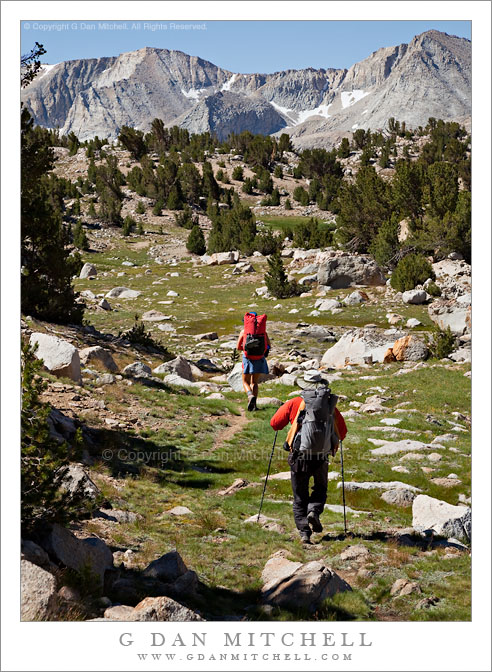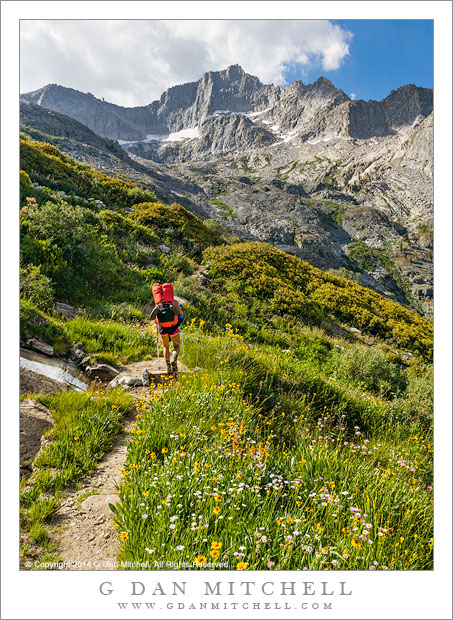I recently was asked a few questions about backpacking photography, mostly related to equipment, so I thought I’d post something to augment an existing article on this website: My Backpacking Photography Equipment. (You’ll probably want to take a look at that one, too!)

Scott emailed recently to ask several questions, and I’ll consider some of them here. His first question has to do with gear, as in “how much” to take. He suggests that it is hard to find a balance between high enough quality imagining, sufficient equipment to cover possibly opportunities, and carrying the stuff! Once you start carrying the stuff on your back, fundamental compromises among conflicting demands are necessary.
He carries the following gear:
With one qualification, that is almost a classic approach (or perhaps a combination of two such approaches) for those who carry full frame DSLR cameras. Canon cameras are obviously not the only option, but I’ll stick with them for now for the purposes of this example.
- The Canon 6D is a slightly smaller and lighter full frame camera that provides excellent image quality.
- Carrying zooms provides excellent image quality and useful flexibility.
- The f/4 zooms reduce weight and bulk by comparison to f/2.8 alternatives.
- The focal length range between 16mm and 200mm is useful for many backcountry photographers.
- The 50mm f/1.8 lens gives a larger aperture in a rather small and light package, and could be useful in low light or other situations.
LENSES
My own three-lens kit for backcountry photography has tended to use similar lenses: a 16-35mm or 17-40mm f/4 zoom, a midrange 24-70 or 24-105mm zoom, and a 70-200mm zoom. Some folks who want to cover the same focal length range but save a bit of weight dispense with the midrange zoom (the 24-105mm in his case) and cover that with the 50mm prime. I prefer the three-zoom approach, and I find that I rarely suffer by not having the larger aperture 50mm prime.) Since this is a matter of preference, I can’t really say which is “better” for other photographers. (If I were to add something to the zoom-only kit, it might be a 1.4x teleconverter.
While I might occasionally miss the 16-24mm range, I do well with only two zooms, the 24-70mm (or to 105mm) and the 70-200mm. Photographers who rely on ultra-wide focal lengths won’t agree.
We often worry that we might miss some shot if we don’t carry enough gear to cover all eventualities. In actual practice this is rarely a problem. In most cases there is some way to photograph almost any subject with the gear you have.
Of course, all of these variables will be affected by things including age, fitness, terrain, and how much distance you plan to cover on the trail. A very fit young backpacker who plans to photograph from a base camp may be willing to carry a lot of stuff, while a less-fit traveler who must cover many miles over difficult terrain every day will likely be willing to work with less equipment.
PACKING
The next topic had to do with how to carry all of the stuff. He asked about some particular brands, but since all of them make good and useful products I won’t offer a particular brand recommendation. In a way, this becomes a technique question as much as a gear question. It also is (yet another) issue that leads us to ask which compromise is the best for our particular approach.
Here, too, there are conflicting demands. We would like to have everything immediately available for instant use. Yet we probably don’t want lots of gear dangling around out necks, and many of us don’t want expensive equipment left unprotected from rain and rocks — at least I don’t.
I think of my gear as fitting into several categories when it comes to access:
- A camera and lens available for quick photography without removing the pack.
- Additional lenses and accessories available with a bit more effort including taking of the backpack.
- Tripod and perhaps other gear for longer stops for serious photography.
I carry/wear a chest harness bag that holds my camera and at least one lens in front of me where I can quickly remove it and make a handheld photograph without removing my backpack. It is large enough to accommodate a full frame camera with a 24-70mm or 24-105mm lens, and possibly let’s me squeeze the 16-35 or 17-40 into the bottom of the bag ready for use. Pockets hold a filter or two and at least one extra battery. Mine has a rain cover that lets me keep moving in light showers. This setup allows me to leave my pack on and quickly grab photographs of people like those included in this article.

My long lens, usually a 70-200mm telephoto, lives inside a padded case in the top of the main compartment of my backpack. It is too large to carry outside the pack while I’m hiking, and having it in the pack protects it from damage and from rain. A few other odds and ends, such as more batteries, also reside in the main backpack. This does necessitate a stop to remove the pack if I need to use the long lens — but that is a compromise I can live with.
My tripod is attached to the rear or side of my backpack (it depends on which pack I’m using), so I definitely have to stop and remove the pack for tripod-based photography. That is inconvenient, but in most cases when I use the tripod I wall take long enough to photograph — and may need to move around on awkward terrain — that I probably would not want to keep the pack on anyway.
WEIGHT AND OTHER PRACTICAL MATTERS
There is (almost) no question that most serious backcountry photography is going to require more serious equipment. (Here I acknowledge that there are folks who are willing to attempt such things with their iPhones or similar gear, but I’m not among them.) This “serious” gear — even the downsized options — tends to be larger and heavier and a bit fussier to use.

All of this conflicts with the typical backpacker mantra of “smaller, lighter, and less” gear. I spent years downsizing my backpacking equipment — smaller and lighter packs and tents, minimizing equipment — only to wipe out all of the gains and then some by adding camera equipment!
Eventually I decided that, at least as one ages, the goal of focusing on photography can be in conflict with the goal of covering a lot of miles. Each backcountry photographer probably has to answer the question of where he/she is on the spectrum between “it is all about the miles” and “it is all about the photographs.” In most cases, my decision is to favor the photographs over the miles.
Fortunately I also discovered, somewhat belatedly, the joys of setting up a base camp and spending a week “working” the surrounding terrain. The load is just as heavy on that first day, but once I’m set up I am free to move quickly and with only camera equipment on my back.
These days there is an interesting middle ground to consider, especially if you rarely make gigantic, fine art prints of your photographs. There is now excellent mirrorless equipment in various format from full frame on down to micro-four-thirds. The smaller formats also permit the use of smaller and lighter lenses. I won’t go into the tradeoffs here (battery life, anyone?) but in many cases these alternatives can be excellent choices.
NO RIGHT ANSWER…
Many photographers are looking for the “best” answer or trying to sort out the “right and wrong” answers. I’m afraid that when it comes to backpacking photography this is even harder than with many other kinds of photography — each photographers needs to work this out for herself or himself.
Since it is helpful to understand what others do and their reasons… how do you handle this? Leave a comment below.
 G Dan Mitchell is a California photographer and visual opportunist. His book, “California’s Fall Color: A Photographer’s Guide to Autumn in the Sierra” is available from Heyday Books and Amazon.
G Dan Mitchell is a California photographer and visual opportunist. His book, “California’s Fall Color: A Photographer’s Guide to Autumn in the Sierra” is available from Heyday Books and Amazon.
Blog | About | Flickr | Twitter | Facebook | Google+ | LinkedIn | Email
All media © Copyright G Dan Mitchell and others as indicated. Any use requires advance permission from G Dan Mitchell.
Discover more from G Dan Mitchell Photography
Subscribe to get the latest posts sent to your email.
